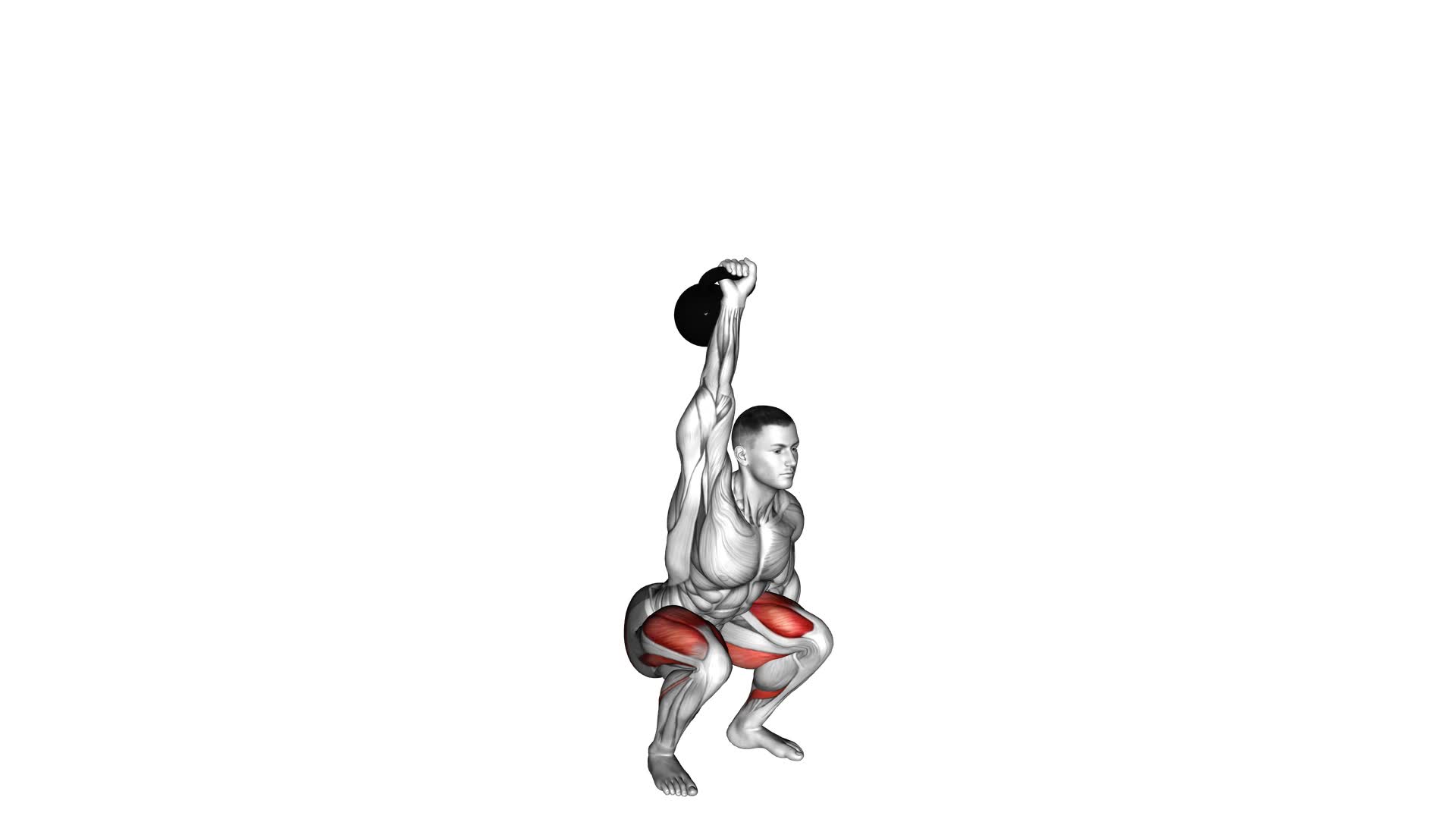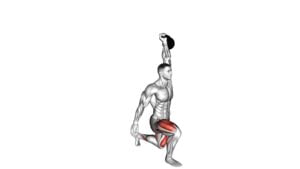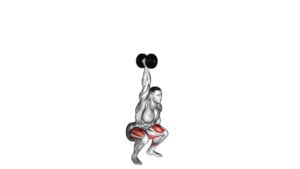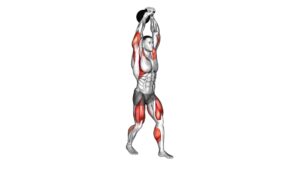Kettlebell One Arm Overhead Squat – Video Exercise Guide & Tips

Are you looking to level up your workout routine?
Watch This Exercise Video
Then the Kettlebell One Arm Overhead Squat is the perfect exercise for you.
In this video exercise guide, we'll show you the proper technique and form to maximize results while avoiding common mistakes.
Whether you're a beginner or a seasoned fitness enthusiast, we've got you covered with progressions and modifications.
Get ready to add this dynamic move to your routine and take your fitness to the next level.
Key Takeaways
- Increased stability
- Improved core strength
- Overall muscular development
- Enhanced balance and coordination
Benefits of the Kettlebell One Arm Overhead Squat
Experience the numerous benefits of the Kettlebell One Arm Overhead Squat, including increased stability, core strength, and overall muscular development. This exercise is highly effective in improving balance and increasing core strength.
By holding the kettlebell overhead with one arm while performing a squat, you're challenging your body to maintain stability and balance, engaging your core muscles throughout the movement.
The Kettlebell One Arm Overhead Squat is a compound exercise that targets multiple muscle groups simultaneously. As you squat down, your legs and glutes are activated, helping to strengthen and tone these areas. Additionally, the overhead position of the kettlebell forces your shoulders and upper back to work harder, enhancing your upper body strength and posture.
One of the key benefits of this exercise is its ability to improve balance. By holding the kettlebell overhead, you're forced to engage your core to maintain stability. This not only helps to prevent falls and injuries but also enhances your overall balance and coordination.
Furthermore, the Kettlebell One Arm Overhead Squat is an excellent exercise for increasing core strength. As you perform the squat, your core muscles, including your abdominals and obliques, are actively engaged to stabilize your spine and pelvis. This helps to develop a strong and stable core, which is essential for maintaining proper posture and preventing lower back pain.
Proper Technique and Form for the Exercise
To perform the Kettlebell One Arm Overhead Squat correctly, you should focus on maintaining proper technique and form throughout the exercise. Here are some key points to keep in mind:
- Keep your core engaged and maintain a neutral spine throughout the movement.
- Start with a kettlebell in one hand and press it overhead with your arm fully extended.
- As you squat down, keep your weight in your heels and push your hips back, maintaining a straight line from your head to your heels.
- Keep your chest up and your shoulders back to prevent rounding of the upper back.
- As you descend into the squat, aim to reach parallel or lower, ensuring your knees track over your toes.
Common errors to watch out for include:
- Allowing your knees to cave inwards.
- Losing tension in your core and rounding your lower back.
- Not fully extending your arm overhead or allowing it to collapse forward.
Variations of the Kettlebell One Arm Overhead Squat include using different kettlebell weights, performing the exercise with a goblet grip, or adding a pause at the bottom of the squat for increased difficulty.
Common Mistakes to Avoid
To avoid common mistakes while performing the Kettlebell One Arm Overhead Squat, focus on maintaining proper form and technique. Common errors in performing the kettlebell one arm overhead squat include improper alignment of the torso, lack of stability in the core, and incorrect hand positioning.
To fix these mistakes, ensure that your torso remains upright throughout the movement, avoiding excessive leaning forward or backward. Engage your core muscles to maintain stability and prevent any swaying or wobbling. Additionally, make sure to hold the kettlebell securely with your hand directly over your shoulder, keeping your wrist straight and avoiding any excessive bending or twisting.
By addressing these common mistakes, you can optimize your performance and reduce the risk of injury.
Now, let's move on to the next section, which will discuss progressions and modifications for all fitness levels.
Progressions and Modifications for All Fitness Levels
To progress and modify the Kettlebell One Arm Overhead Squat for all fitness levels, adjust the weight and repetition range according to your individual abilities and goals. Here are some progressions and modifications that can help you tailor this exercise to your needs:
- Start with a lighter kettlebell and focus on mastering the technique before increasing the weight.
- Gradually increase the weight as you become more comfortable and confident with the movement.
If you're unable to perform the exercise with a kettlebell, try using a dumbbell or even just your bodyweight to work on your squat form.
If you find the one-arm overhead squat challenging, you can start by using both arms to hold the kettlebell overhead, then gradually progress to using just one arm.
If you have any mobility restrictions or limitations, consider modifying the exercise by performing a regular squat without the overhead component.
Tips for Incorporating the Kettlebell One Arm Overhead Squat Into Your Workout Routine
Now, let's delve into incorporating the Kettlebell One Arm Overhead Squat into your workout routine by focusing on proper form and technique.
There are a few variations of the kettlebell one arm overhead squat that you can try to add variety to your workouts.
One variation is the goblet squat, where you hold the kettlebell in front of your chest with both hands. This variation can help improve your squatting form and build strength in your legs and core.
Another variation is the single-arm front squat, where you hold the kettlebell with one hand in front of your shoulder. This variation challenges your core stability and upper body strength.
To increase the intensity of the kettlebell one arm overhead squat, you can try using a heavier kettlebell or increasing the number of reps. You can also try slowing down the tempo of the exercise to make it more challenging.
Another way to increase intensity is to incorporate pauses at the bottom of the squat or add a pulse at the top of the movement. Additionally, you can try performing the exercise on an unstable surface, such as a balance board or Bosu ball, to engage more muscles and improve your balance.
Remember to always listen to your body and start with lighter weights or modifications before progressing to more challenging variations.
Frequently Asked Questions
How Heavy Should the Kettlebell Be for the One Arm Overhead Squat?
When determining the kettlebell weight for the one arm overhead squat, consider your strength and experience level. Start with a lighter weight and gradually increase as you become more comfortable.
It's important to listen to your body and avoid pushing yourself too hard. If you have any injuries or limitations, consult a fitness professional for modifications.
Can I Still Do the One Arm Overhead Squat if I Have Shoulder or Wrist Issues?
If you have shoulder or wrist issues, modifications for the one arm overhead squat can help. It's important to prioritize your safety and comfort. You can try using a lighter kettlebell or even just your body weight. Alternatively, you can use a dumbbell or resistance band to mimic the movement.
The one arm overhead squat offers numerous benefits, such as improving core strength, stability, and mobility. It's a great addition to your workout routine.
How Many Reps and Sets Should I Do for the One Arm Overhead Squat?
When it comes to the one arm overhead squat, the number of reps and sets you should do depends on your fitness level and goals. It's important to start with a weight that challenges you but doesn't compromise your form.
Aim for 3-5 sets of 8-12 reps to improve strength and muscle endurance. As you progress, gradually increase the weight and decrease the reps for a more challenging workout.
Always listen to your body and adjust accordingly.
Is the One Arm Overhead Squat Suitable for Beginners?
Yes, the one arm overhead squat can be suitable for beginners. It's important to focus on proper form and technique to prevent injury. Start with a lighter weight kettlebell and gradually increase as you build strength and stability.
Make sure to keep your core engaged, chest lifted, and squat down with control. As you progress, you can work towards using a heavier kettlebell and increasing the depth of your squat.
What Muscles Does the One Arm Overhead Squat Primarily Target?
When you do the one arm overhead squat, you primarily target your core, glutes, quads, and shoulders. Incorporating this exercise into your routine has many benefits, such as improving your balance, stability, and overall strength.
However, it's important to avoid common mistakes like leaning forward or letting your knees cave in. By performing the one arm overhead squat correctly, you can maximize its effectiveness and minimize the risk of injury.
Conclusion
In conclusion, the kettlebell one arm overhead squat is a highly effective exercise that offers numerous benefits for your overall fitness.
By following proper technique and form, while avoiding common mistakes, you can maximize the results of this exercise.
Additionally, there are progressions and modifications available for all fitness levels, making it accessible to everyone.
Incorporating the kettlebell one arm overhead squat into your workout routine can help you improve strength, stability, and mobility.

Author
Years ago, the spark of my life’s passion ignited in my mind the moment I stepped into the local gym for the first time. The inaugural bead of perspiration, the initial endeavor, the very first surge of endorphins, and a sense of pride that washed over me post-workout marked the beginning of my deep-seated interest in strength sports, fitness, and sports nutrition. This very curiosity blossomed rapidly into a profound fascination, propelling me to earn a Master’s degree in Physical Education from the Academy of Physical Education in Krakow, followed by a Sports Manager diploma from the Jagiellonian University. My journey of growth led me to gain more specialized qualifications, such as being a certified personal trainer with a focus on sports dietetics, a lifeguard, and an instructor for wellness and corrective gymnastics. Theoretical knowledge paired seamlessly with practical experience, reinforcing my belief that the transformation of individuals under my guidance was also a reflection of my personal growth. This belief holds true even today. Each day, I strive to push the boundaries and explore new realms. These realms gently elevate me to greater heights. The unique combination of passion for my field and the continuous quest for growth fuels my drive to break new ground.







